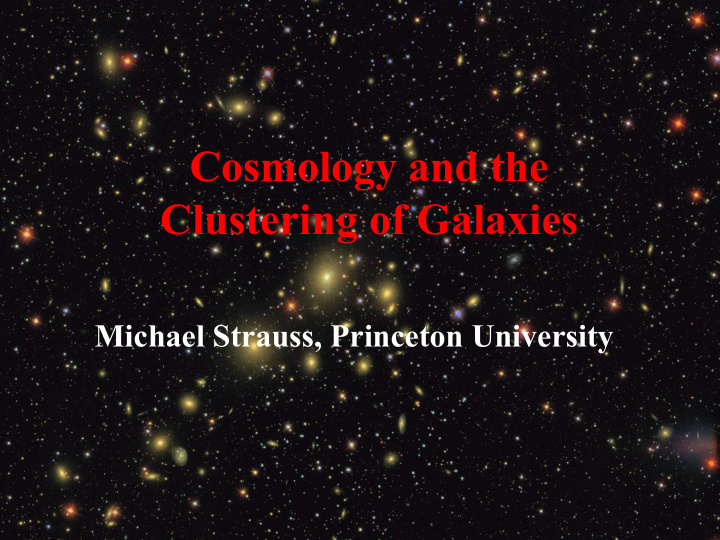



Cosmology and the Clustering of Galaxies Michael Strauss, Princeton University
An image of the sky shows nearby stars, distant galaxies all projected into two dimensions
The distribution on the sky of almost 400,000 galaxies. We use redshifts to map these in three dimensions. Sloan Digital Sky Survey 7th Data Release
Edwin Hubble ’s original diagram, to 6 million light years. Velocity Distance is measured using inverse square relation between luminosity, brightness and distance. Distance Velocity A modern version, to 1.5 billion light years. The recession velocity is proportional to distance (the Hubble Law), implying uniform expansion . Distance
Each of the more than ten thousand dots in this figure represents a galaxy of hundreds of billions of stars.
Stepping back further… 6.5 billion light years
Where did all this incredibly rich structure come from? To answer this, we have to turn to a different kind of map… Because of the expansion of the universe, it was much hotter and denser in the past than today.
The Cosmic Microwave Background • The early dense universe was very very hot. • Hot things give off light. Thus we can hope to see the light that was given off by material in the very early universe. • This prediction was dramatically confirmed in 1965 with the discovery of the Cosmic Microwave Background (CMB). This discovery convinced the astronomical community that the universe evolved from a hot dense state.
Mapping a sphere onto a flat plane.
The Big Bang happened everywhere at once, so the CMB should be coming to us from all directions. What does it actually look like? A map of the CMB from the full sky, projected onto an ellipse.
From the Big Bang to the Present • If the Universe was so smooth then, how did it become so interestingly structured today? • The early universe was not perfectly smooth. Slightly dense regions have a stronger gravitational pull, and draw material to them to make them denser, increasing the gravity, pulling yet more material… • Gravity sucks ! (Jim Peebles) • Thus hidden in the smoothness of the CMB must be subtle undulations from which the current structure of the universe arose. Our job: let us measure both the CMB fluctuations, and the present-day structure: does the picture hold together?
What we see when we crank up the contrast: Part-in-1000 variations in temperature due to the 300 km/s motion of the Earth relative to the universe as a whole. Intrinsic fluctuations are at the level of one part in 100,000!
Wilkinson Microwave Anisotropy Probe: The Structure of the Early Universe The CMB is not perfectly smooth!
Statistical measurements of the structure in the CMB maps, and that in the galaxy distribution, are well-described by our modern cosmological model.
Choi et al (released last week!) showing the comparison of CMB statistics and the prediction of our modern cosmological model.
Neveux et al (released this week!) showing the agreement between measurements of galaxy clustering and predictions of our modern cosmological model.
Our cosmological model includes some strange ingredients: • Dark matter, whose presence is inferred only from its gravitational influence on galaxies; • Dark energy, which causes the expansion of the universe to accelerate. • We don’t know what either of these are, physically!
How do we explore the faint and distant universe, to explore the evolution of dark matter and dark energy?
Rubin Observatory Artist Conception. Credit Todd Mason, Mason Productions Inc. / LSST Corporation
Recommend
More recommend